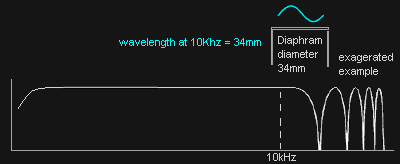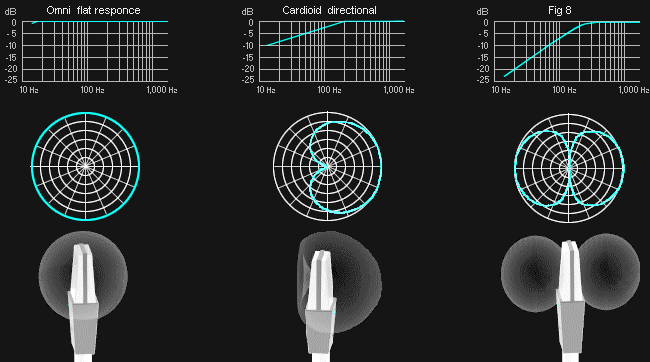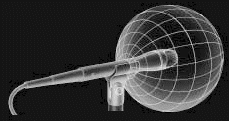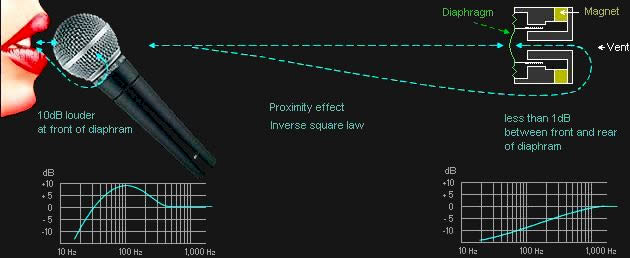Diaphragm size A large diaphragm gives improved directivity at higher frequencies and a larger output voltage and therefore a better the signal to noise ratio. But large diaphragms have a simple limitation similar to loudspeakers. The highest frequency is limited to the wavelength that co-insides with the diaphragm diameter. At high frequencies where the wavelengths are smaller than the diaphragm diameter, creates a comb filter effect in the response. However this comb filter effect above 10K Hz can be minimal depending on sound direction and often inaudible.

A small diaphragm diameter has a wider hi-frequency directivity and tends to give a flatter frequency response. The comb-filter effect is pushed well above the audio range. But small diaphragms result in less output level and therefore the signal to noise ratio is less.
Placement If a mic is placed very close to a surface (be it a wall, floor, drum skin or singer's face) it will no longer have the directional characteristics that are specified. Likewise, holding a mic with a hand that cups the back of the mic ball, will change directionality radically and unpredictably. Most microphone specifications only apply in non reverberant free field, at a distance from any reflective surface. The only exception is the boundary mic which is meant to be placed directly on a large flat surface.
www.mipro.com.tw
Live application the number of microphones should be kept to minimum. Unnecessary use of mics creates excessive comb filter distortion. This reduces intelligibility and increases feedback problems. Minimise using different mics. Exceptions are (directional overhead) for percussion and (dynamic high velocity) for bass drums. Placing any mic too close to an instrument or surface, affects its response.
Polar The terms Omni, Cardioid, Hyper-cardioid, Hypo-cardioid, represent polar, phase and frequency response, but these terms are loosely applied. The directivity of all microphones is frequency dependent, and become spherical as the frequency decreases. Directional microphones are also called 'pressure gradient' mics, because their directional characteristics are created by means of varying pressure to the front and rear of the diaphragm (the pressure gradient).

Only the omni has an inherent flat response. The other higher order polar responses must (by definition) alter the received sound to some extent. It is not possible to modify the directional characteristics without also altering the nature of the sound that is picked up. This is not necessarily 'bad', just different.
Increasing directivity is often achieved by sound being allowed to enter the rear of the diaphragm. This can have an added effect of reducing the frequency response at the lower end of the sound spectrum, as the distance increases (generalised in the above pic). There are other arrangements to create directional polar responses by using multiple inserts to achieve minimal effect on degrading the frequency response.
Likewise, many cartridge / capsule types (the actual transducer) have their own sound, whether real or imagined. This often influences the choice of microphone type for different tasks - for example, there are mics that are favoured for bass (kick) drums that may be deemed unsuited for anything else. This is not necessarily true, as experimentation can often demonstrate.
Omni Directional Omni refers to the frequency response being flat, and 'phase coherent' from all directions. Many stage Omnis' have good directivity This is not to be confused with the polar directivity of cardioid in which the phase and frequency response change off axis. Omni give less feedback problems, in live application compared to most cardioid.

Omni have minimal to zero proximity effect, are consistent with vocal movement, and therefore suited to singers who have good management technique, enabling the level to be easily controlled by distance. Omnis are also better suited to instruments. Omni mics are less used for live production compared to cardioid because of ignorance and limited understanding. However Omnis' with full spherical directivity are for recording and not suited to live productions.
Cardioid mics often have a proximity affect to colour and enhance the voice at close range. Different Cardioid mics suit male and female singers. Singers should own their mics and be skilled in the techniques of using them, as musicians owning their instruments.
Cardioid mics are often misused for instruments, typically used in very close proximity to drum skins (among other misuses). But if this gives a specific sound required, then it is no longer misuse.
Hyper Cardioid This is an exaggerated version of the cardioid mic, so it is more directional. A side-effect is that a small lobe is created at the rear of the microphone, so these mics must never be 'aimed' so that the rear lobe points towards a floor monitor (for example). Sometimes a distinction is made between 'super' and 'hyper' cardioid microphones, but other descriptions will consider them to be equivalent.
Fig 8. The figure-8 mic picks up sound equally well from the front and back, but rejects sound coming from the sides (as well as top, bottom, etc.). The pattern can be looked at as an extreme form of hyper-cardioid, where the front and rear lobes are equal in amplitude and frequency response. Many dual element microphones combine an omni and figure 8 capsule to allow switchable directivity.

Shotgun The length of a shotgun does not give it greater directionality but enables it to maintain directionality at lower frequencies. The slots along the microphone body enable sound from the sides to reach the rear of the microphone diaphragm and therefore cancel the sound from the front. The microphone must be suspended at a distance away from obstructing surfaces for it to function correctly. Many shotgun mics also use multiple inserts to improve directionality.
Proximity effect of Cardioid Mics
Proximity is the most controversial effect that plagues some cardioid microphones. When using some cardioid mics close to the lips the bass response increases in a way that appears to be out of control. The proximity effect can be used as an advantage giving a fuller sound for singers with a shallow voice. The proximity effect also gives male singers an artificial pre-emphasises of sounding like having larger balls. However at larger distances 3ft or 1m a cardioid mic may have the opposite effect, that is, the bass response is shallow.

Cardioid directionally is often achieved by enabling off axis sound to enter through a rear vent to the back of the diaphragm. However for the sound to cancel, it must arrive at both sides of the diaphragm, at the same level at the same time. When the mic is close to the lips, the distance to the front of the diaphragm is very short, and more than double the SPL level, than for the same sound to travel double the distance to the rear of the diaphragm (Inverse square law). This is the primary reason the bass response appears to increase dramatically.
As the mic distance is increased the level SPL difference between sound arriving at the front and rear of the microphone becomes less. The lower frequencies cancel more readily regardless of the direction of the sound source (Inverse square law). The rear vent is less effective at higher frequencies where the mic appears to maintain a consistent directional response. Some manufacturers go to extraordinary effort to minimise proximity effect and have various tuned vents to maintain a consistent cardioid polar response over the whole frequency range.
Whether a microphone or a speaker box has an extra hole (port) to improve its bass resonance, or control its directivity, the results for both are the same in creating other complexities that are often un-wanted. Because marketing focuses on the positives and not the negatives of a compromise we are sometimes quite happy to negate what we don't want to know. This is also seen on a larger scale in the marketing behaviour of drug companies.
The links below also give further explanations of the proximity effect of cardioid mics.
www.dpamicrophones.com Proximity_Effect DPA Microphone University
www.soundonsound.com/proximity-effect notes on proximity effect
www.soundguys.com/proximity-effect-explained notes on proximity effect
Basic Specifications
Output level of Mics are rated in milli-volts per Pascal (mV /Pa)
1Pascal = 10micro-Bar = 94dB SPL
Average speech at 1 Meter = 0.1Pascal = 1micro-Bar = 74dB SPL


